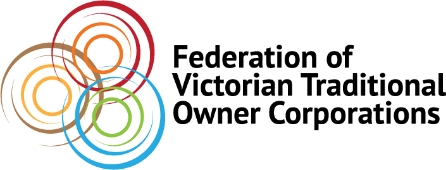The Federation is delivering the Aboriginal Culture and Healing Flood Recovery Grant Program.
Two round of grants have been available to Aboriginal communities and Traditional Owner groups to lead flood recovery work in areas of Victoria affected by the October 2022 floods.
The program seeks to recognise the disproportionate impact natural disasters have on Aboriginal communities and the central role they play in leading recovery efforts.
Six projects were funded under the program’s first round in 2023 and 10 under a second round in 2024-25.
The Aboriginal Culture and Healing Flood Recovery Grant Program’s objectives are:
- Aboriginal people’s unique experiences of trauma are addressed and healing supported
- Recovery and resilience are strengthened through Aboriginal culture, knowledge, and the connection between Country and healing
- Aboriginal communities have increased capability to lead recovery and healing.
Please read the funding guidelines and template grant agreement carefully to ensure your organisation and project are eligible.
When you’re ready, please complete the application form, then send the completed application form to [email protected] before 5pm on 19 August 2024.
For questions about applications, please contact the Federation’s Grants Administration team at [email protected]
Eligible applicants will:
- be an Aboriginal organisation and/or social enterprise (may be supported by auspice organisations);
- be in a listed Victorian local government area directly impacted by the October 2022 floods; and
- demonstrate that their project is relevant to the flood-affected area.
Funding guidelines with more information on round two eligibility will be published on 23 July. See round one funding guidelines here.
Round one of the Aboriginal Culture and Healing Flood Recovery Grant Program funded six Aboriginal organisations to lead flood-recovery projects in the first half of 2024.
Barengi Gadjin Land Council (BGLC)
BGLC’s project will rebuild damaged pathways and infrastructure at its Dalki Garringa Native Nursery, which was left in disarray after the floods. The project focuses on renovating and stabilising the paths, refurbishing drainage systems, and controlling weeds and will be delivered by a local Indigenous workforce.
Duduroa Dhargal Aboriginal Corporation (DDAC)
DDAC’s project will deliver workshops over two weekends at Ryan’s Lagoon, an important cultural wetland area that was impacted by the floods. The workshops will focus on building the capacity and cultural knowledge of community members. The workshop agenda will include topics such as plant identification and use (including weaving), sharing of stories and protection of the native turtle species.
Dja Dja Wurrung Clans Aboriginal Corporation (DJAARA)
DJAARA’s project will undertake assessments of cultural heritage sites on Djandak (Country) to determine which places have been affected by the floods and to what extent. The information collected will provide scope for DJAARA to plan for the management and healing of these sites and enable DJAARA to identify and mitigate the future flood risk to cultural heritage places.
Eastern Maar Aboriginal Corporation (EMAC)
EMAC’s project will financially support 10 Eastern Maar citizens to undertake Certificate III units at South West TAFE relating to flood recovery, waterway management and rehabilitation. This will build the capacity of community to prepare for flood emergencies that will impact Eastern Maar Country and assets and equip them with the skills necessary to act in both emergency response and flood recovery.
Moogji Aboriginal Council East Gippsland Inc (Moogji)
Moogji’s project will repair and rehabilitate flood damage that occurred at its 40-acre Bonang Property, which is home to a nursery, a community garden and a cultural trail. Key activities include debris removal, topsoil replacement, weed control, water diversion and irrigation works, and revegetation. Community members will have the opportunity to work on-Country in delivering the project.
Wurundjeri Woi-wurrung Cultural Heritage Aboriginal Corporation (WWWCHAC)
WWWCHAC will investigate flood-impacted areas of Wurundjeri Country through remote sensing methods (flood data analysis and flood level mapping). Data gathered will inform targeted on-Country walks for Wurundjeri people and staff to investigate and record impacted sites and landscapes, which will lead to updates of the Victorian Aboriginal Heritage Register. The project will be supported by the University of Melbourne.
Ten diverse projects will support Aboriginal community-led healing and recovery – meeting flood-affected communities’ psychological and wellbeing needs, mapping and restoring damaged Country, reconnecting with Country through workshops and cultural storytelling, and action planning to mitigate future flood impacts.
Aboriginal Community Elder Service (ACES)
ACES provides various care services to Aboriginal community Elders who live in or across the 63 flood-affected local government areas. ACES’ project will provide culturally safe services and support to Elders affected by the floods, including visits and welfare calls from dedicated support workers, distribution of emergency packs, and supporting emergency planning through preparation of emergency evacuation plans for Elders in flood-prone areas.
Albury Wodonga Aboriginal Health Service (AWAHS)
The Albury Wodonga community experienced significant flooding, which caused widespread disruption and distress among residents. AWAHS will manage the significant psychological effects of disaster by employing a psychologist, developing health promotion materials and running community engagement activities, to meet community members’ psychological needs, foster resilience, and ensure vital mental health support remains available during the recovery process.
Bangerang Aboriginal Corporation (Bangerang)
Bangerang’s Dunggudja Wala Healing Project will address the significant impacts of the floods on Bangerang Country and people by employing a Bangerang (identified) project officer, to connect community members to culturally safe support services, and facilitate on-Country workshops that strengthen connection to Country, culture, knowledge and traditions. The project will enable Bangerang People to recover from the impacts of the floods and build resilience and capability to respond to natural disasters in the future. Dunggudja Wala means big water in Bangerang language.
DJAARA
DJAARA’s project will implement, test and iterate the Flood Assessment Predictive Model it developed with the support of this program’s first round of funding, which identifies how Dja Dja Wurrung Cultural Heritage sites may be impacted by future flooding events, and applies Traditional Ecological Knowledge to mitigate risk, manage impacts, and protect Cultural Heritage.
Eastern Maar Aboriginal Corporation (EMAC)
EMAC’s project will enable its 35 On Country Guardians to conduct Aboriginal Waterway Assessments and restore, recover and protect Country along flood-affected sections of the Hopkins River and Mount Emu Creek. The work will include weed control, revegetation and fencing – building future flood resilience – and contributing to self-determination by connecting On Country Guardians to place.
First People of the Millewa Mallee Aboriginal Corporation (FPMMAC)
Mildura’s 15-hectare Lock Island – a sanctuary for wildlife and a focus of tourism in the Murray River area – was significantly impacted by the October 2022 floods. FPMMAC’s project will remediate the island, focusing on cleanup, recovery, track remediation and regeneration, improving biodiversity, and increasing opportunities for cultural learning and storytelling. FPMMAC will deliver this project with Mildura Regional Development, Mildura Rural City Council, Goulburn Murray Water, DEECA, and Mallee CMA.
Oonah Health and Community Services Aboriginal Corporation (Oonah)
Oonah provides social and emotional support services to Aboriginal communities in Melbourne’s inner and outer east. Its Healing with Oonah project will provide group-based healing and cultural connection, to ease anxiety around future flood events and build community members’ resilience and confidence. Participants will have access to groupwork, on-Country activities, individualised support, and other Oonah support services.
Tati Tati Kaiejin (Tati Tati)
The historic mismanagement of cultural flows across Tati Tati waterways resulted in significant rubbish and debris arising with the floods. Tati Tati’s project will assess flood impact on Country and cultural heritage by employing a Tati Tati Flood Recovery Officer, who will carry out on-Country assessments at Margooya Lagoon, Gadsden Bend Park and Bumbang Island, to assess how sites are feeling physically and spiritually, and conduct preliminary site clean-up and restoration as the water recedes – including testing water health, monitoring fish, surveying surrounding wildlife, and revegetating native plants.
Wayapa Wuurrk
Twenty Aboriginal people from the 63 flood-affected areas will become accredited Wayapa Wuurrk Practitioners under the Creating Healing, Recovery & Resilience with Country for Community, the Wayapa Wuurrk Way project. The seven-day training will deepen participants’ connection to Country, strengthen cultural identity, enliven their commitment to support community, and increase the wellbeing and resilience of up to 20 flood-affected communities.
Yorta Yorta Nations Aboriginal Corporation (YYNAC)
YYNAC’s Cultural Heritage Unit will create a Scar Tree Survey to assess flood damage to 271 scar trees registered in Barmah National Park and Barmah Island. The survey will supervise trees in a culturally safe way, carefully report on their current condition, and detail future management practices to preserve trees and mitigate flood risk. The survey team will comprise a qualified archaeologist and two Traditional Owners, who will be trained in scar tree survey and assessment, which will increase YYNAC’s capabilities ahead of future flood events.
The Federation has partnered with Emergency Recovery Victoria to deliver the Aboriginal Culture and Healing Flood Recovery Grant Program.
The Federation’s role involves:
- promoting the grant program to potential applicants
- supporting potential applicants to develop and submit strong grant applications
- overseeing successful project reporting and acquittal
The Federation is a conduit between grant applicants and Emergency Recovery Victoria and is the contact point for all prospective and successful applicants.
For general information, please contact the Federation’s Grants Administration team at [email protected]
To discuss a specific project, please contact Jill Webb on 0408 586 297 or [email protected]

